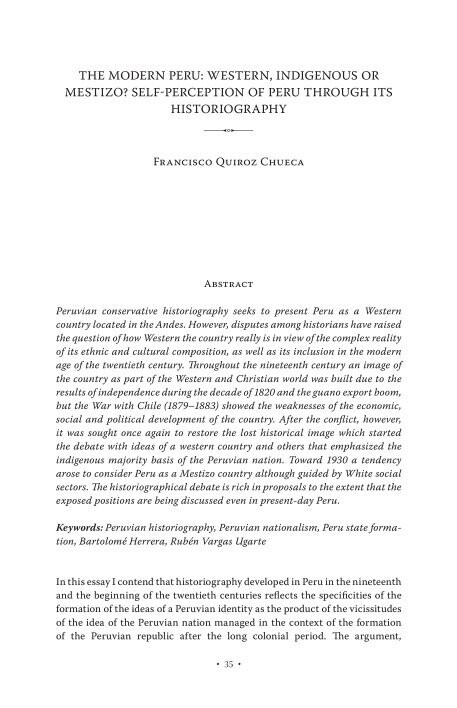
Page 36 [36]

OCR
THE MODERN PERU: WESTERN, INDIGENOUS OR MESTIZO? SELF-PERCEPTION OF PERU THROUGH ITS HISTORIOGRAPHY —o FRANCISCO QUIROZ CHUECA ABSTRACT Peruvian conservative historiography seeks to present Peru as a Western country located in the Andes. However, disputes among historians have raised the question of how Western the country really is in view of the complex reality of its ethnic and cultural composition, as well as its inclusion in the modern age of the twentieth century. Throughout the nineteenth century an image of the country as part of the Western and Christian world was built due to the results of independence during the decade of 1820 and the guano export boom, but the War with Chile (1879-1883) showed the weaknesses of the economic, social and political development of the country. After the conflict, however, it was sought once again to restore the lost historical image which started the debate with ideas of a western country and others that emphasized the indigenous majority basis of the Peruvian nation. Toward 1930 a tendency arose to consider Peru as a Mestizo country although guided by White social sectors. The historiographical debate is rich in proposals to the extent that the exposed positions are being discussed even in present-day Peru. Keywords: Peruvian historiography, Peruvian nationalism, Peru state formation, Bartolomé Herrera, Rubén Vargas Ugarte In this essay I contend that historiography developed in Peru in the nineteenth and the beginning of the twentieth centuries reflects the specificities of the formation of the ideas of a Peruvian identity as the product of the vicissitudes of the idea of the Peruvian nation managed in the context of the formation of the Peruvian republic after the long colonial period. The argument, + 35 +
structurelles
Custom
Image Metadata
- Largeur de l'image
- 1830 px
- Hauteur de l'image
- 2834 px
- Résolution de l'image
- 300 px/inch
- Taille du fichier d'origine
- 886.61 KB
- Lien permanent vers jpg
- 022_000037/0035.jpg
- Lien permanent vers OCR
- 022_000037/0035.ocr
